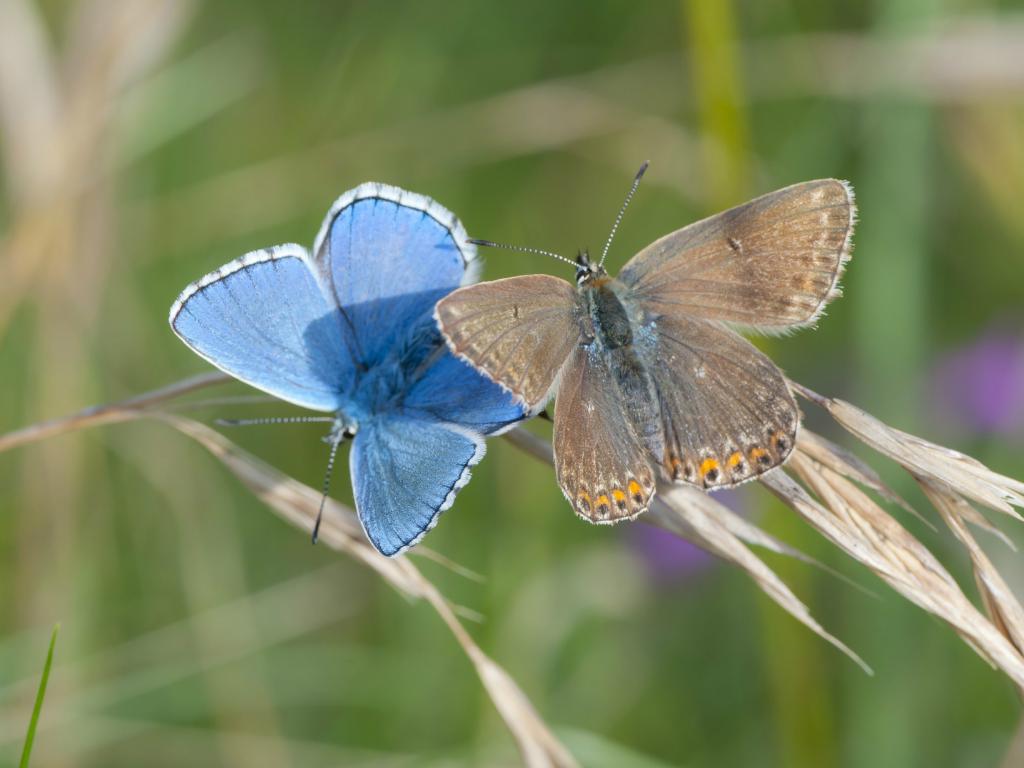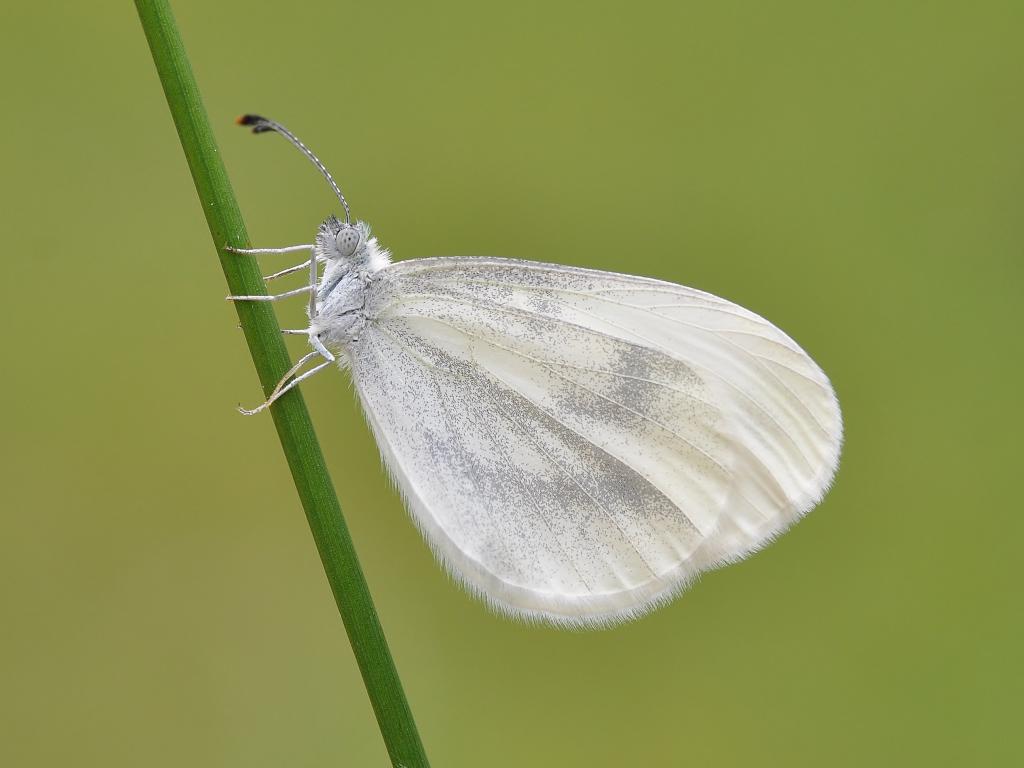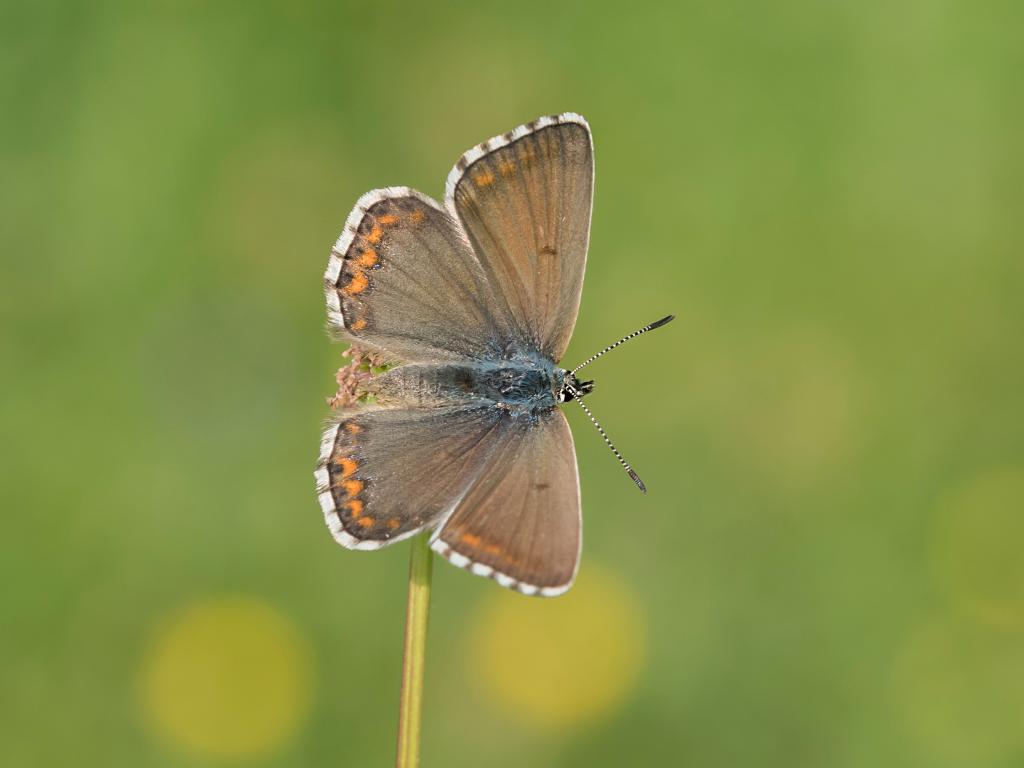
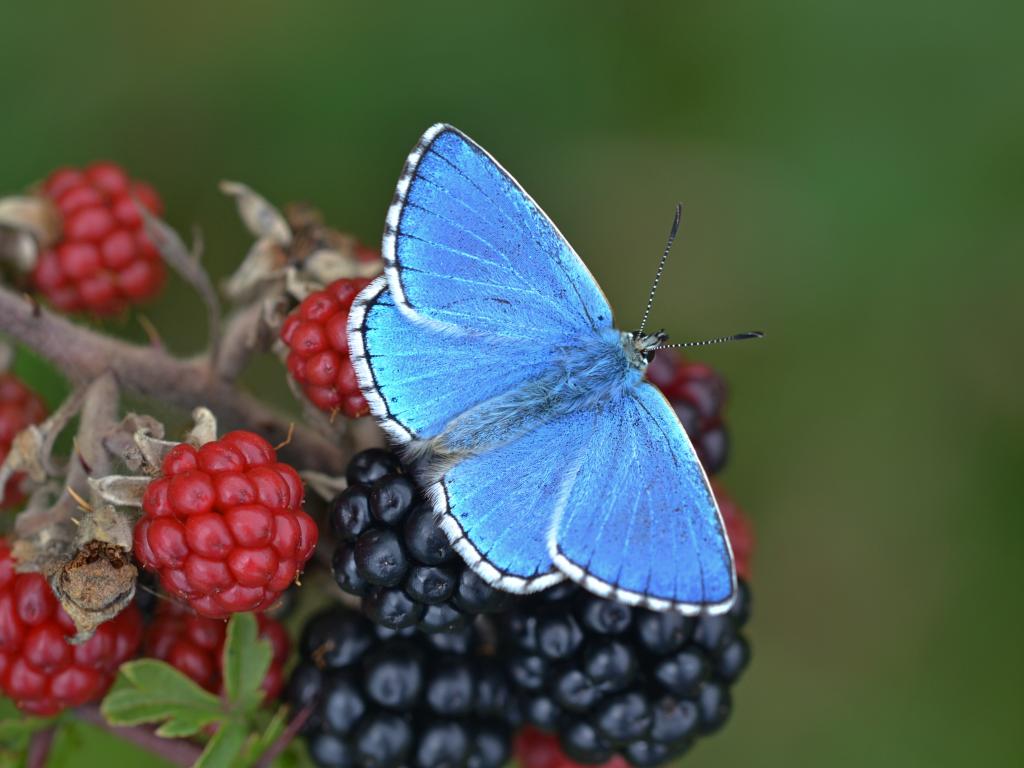
This beautiful species of butterfly is one of the most characteristic of unimproved southern chalk downland, where it can be seen flying low over shortly grazed turf (typically steep, south-facing slopes).
The males have brilliant sky-blue wings, while the females are chocolate brown and far less conspicuous. Both sexes have distinctive black lines that enter or cross the white fringes of the wings.
The white, textured disc-shaped eggs are laid singly under young, unshaded Horseshoe Vetch leaves in May-June and August-September. They can be found most easily in September where unshaded Horseshoe Vetch is growing on short turf.
The Adonis Blue overwinters as a caterpillar; it is is green with short, yellow stripes, which camouflage it while it feeds on Horseshoe Vetch during the day. It is most commonly seen during April and late July as it searches for ants to ‘milk’ its sugary secretions.
In April-May and July-August the caterpillar forms into a chrysalis in small crevices or hollows and is then buried by ants in earth chambers connected to the ant nest. The ants constantly attend to it for around three weeks, protecting it from predators.
This species has undergone a major decline through its entire range but, despite its restricted distribution, on good sites it can be seen in many hundreds, as it has recently re-expanded in some regions.
Colonies vary in size considerably from year to year, depending on the weather. Many thousands can be seen emerging towards the end of a hot summer, constrasting with under a hundred from a spring emergence.
Size and Family
- Family: Blues
- Size: Small/Medium
- Wing Span Range (male to female): 38mm
Conservation Status
- UK BAP: Not listed (formerly Priority)
- Butterfly Conservation priority: Medium
- European status: Not threatened
- Protected under Schedule 5 of the 1981 Wildlife and Countryside Act (for sale only)
Caterpillar Foodplant
The sole foodplant is Horseshoe Vetch (Hippocrepis comosa).
Lifecycle

Habitat
Dry chalk or limestone grassland with abundant foodplants in short turf, but slightly taller vegetation may be used in sheltered quarries. Most colonies occur on warm, south-facing slopes where favoured breeding areas are sheltered hollows (especially old chalk pits and quarries).
Habitat
Dry, chalk or limestone grassland withabundant foodplants growing in short turf1-4 cm tall, except in sheltered quarrieswhere slightly taller vegetation may be used.The autumn generation selects shorter turfthan the spring generation which can lay eggson vegetation up to 8 cm tall. Most coloniesoccur on warm, south-facing slopes wherefavoured breeding areas include shelteredhollows, especially old chalk pits and quarries.
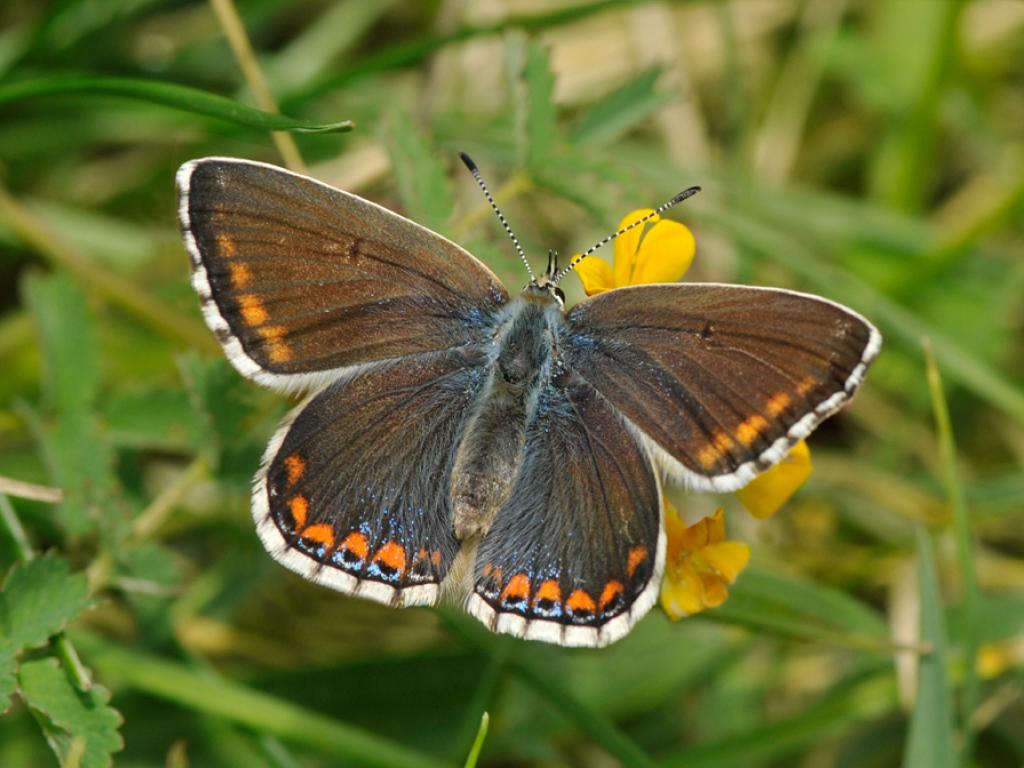
The rare Adonis blue can be spotted on sunny chalk grasslands throughout summer. Males are a dazzling sky-blue in colour, while females are duller brown.
Statistics
Wingspan: 3.0-4.0cm
Conservation status
Protected in the UK under the Wildlife and Countryside Act, 1981.
The Adonis blue is the rarest of the blue butterflies in the UK. It is found on sunny, south-facing grassland that is rich in herbs. It doesn’t travel far, so colonies can become isolated and vulnerable to extinction if their habitat is disturbed. This species has two broods per year, so adults can be seen from mid-May until the end of June, and then from early August until the end of September. Both caterpillars and adults feed on horseshoe vetch.
How to identify
Male Adonis blues are a vivid, sky-blue or turquoise colour. There are fine black lines on the wings that extend into the white fringe. Females are generally brown, though this can vary and some may be quite blue.
Habitat: The Adonis needs warmth, so it chooses the hottest parts of unimproved chalk or limestone grasslands where there is plenty of its food plant. Steep south-facing slopes are often suitable, especially if the grass is short or sparse, allowing the sun to bake the ground. More overgrown sites have smaller numbers of these butterflies.
Caterpillar foodplants: Horseshoe Vetch
Best places: Ballard Down, Bindon Hill, Clubmens Down, Durlston Country Park, Fontmell Down.
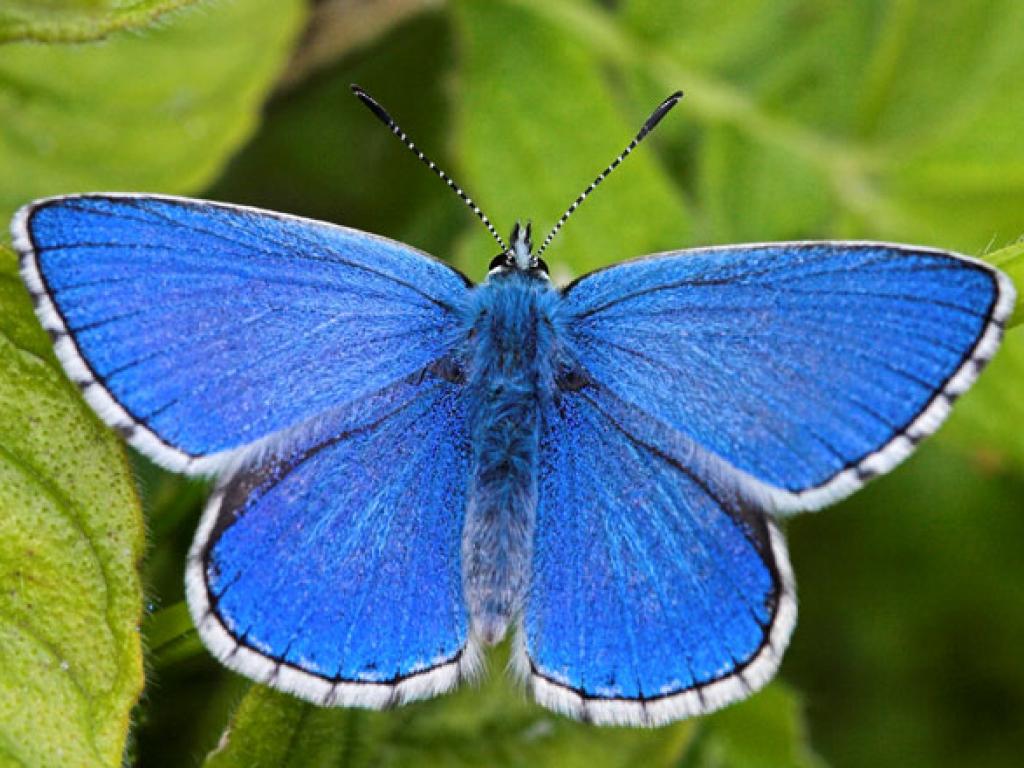
Life cycle
There are two broods per year, with adults flying from mid-May to mid-June, andearly August to mid-September. The eggs are laid singly on very small foodplantsgrowing in short turf. These conditions provide a very warm microclimate for larvaldevelopment and are favoured by ants, which tend both larvae and pupae. The greenlarvae are well camouflaged and are nearly always attended by ants, which are attractedby secretions from special ‘honey’ glands and pores. Any ant species appears suitable,but the most common are the red ant Myrmica sabuleti and the small black antLasius alienus. The ants protect the larvae from predators and parasitoids, and evenbury the larvae (in groups of up to eight) in loose earth cells at night. The Adonis Blueoverwinters in the larval stage and pupates in the upper soil surface, often within antnests where pupae continue to be attended by ants until the adults emerge.
Colony structure
The Adonis Blue is strongly colonial and quite small barriers of scrub or hedgerowcan be enough to separate colonies. However, some individuals are capable ofdispersing and the species has re-colonised sites over distances of 10-15 km.There is also evidence that populations on smaller and more isolated sites aremore prone to extinction, and that their persistence may depend on being partof a larger metapopulation, covering a network of sites. Nevertheless, habitatquality is a crucial factor in determining colony occurrence and persistence.

